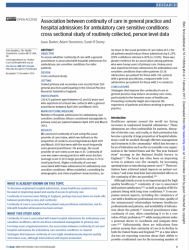
Objective To assess whether continuity of care with a general practitioner is associated with hospital admissions for ambulatory care sensitive conditions for older patients.
Design Cross sectional study.
Setting Linked primary and secondary care records from 200 general practices participating in the Clinical Practice Research Datalink in England.
Participants 230 472 patients aged between 62 and 82 years and who experienced at least two contacts with a general practitioner between April 2011 and March 2013.
Main outcome measure Number of hospital admissions for ambulatory care sensitive conditions (those considered manageable in primary care) per patient between April 2011 and March 2013.
Results We assessed continuity of care using the usual provider of care index, which we defined as the proportion of contacts occurring between April 2011 and March 2013 that were with the most frequently seen general practitioner. On average, the usual provider of care index score was 0.61. Continuity of care was lower among practices with more doctors (average score 0.59 in large practices versus 0.70 in small practices). Higher continuity of care was associated with fewer admissions for ambulatory care sensitive conditions. When modelled, controlling for demographic and clinical patient characteristics, an increase in the usual provider of care index of 0.2 for all patients would reduce these admissions by 6.22% (95% confidence interval 4.87% to 7.55%). There was greater evidence for an association among patients who were heavy users of primary care. Heavy users also experienced more admissions for ambulatory care sensitive conditions than other patients (0.36 admissions per patient for those with ≥18 contacts with a general practitioner, compared with 0.04 admissions per patient for those with 2-4 contacts).
Conclusions Strategies that improve the continuity of care in general practice may reduce secondary care costs, particularly for the heaviest users of healthcare. Promoting continuity might also improve the experience of patients and those working in general practice.
| Fichier attaché | Taille |
|---|---|
| 290.74 KB |

